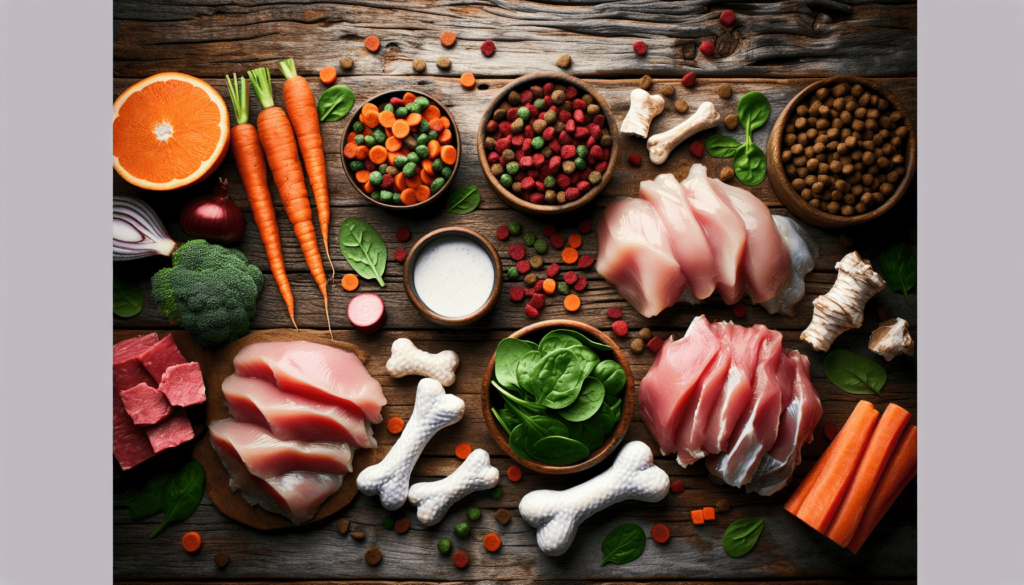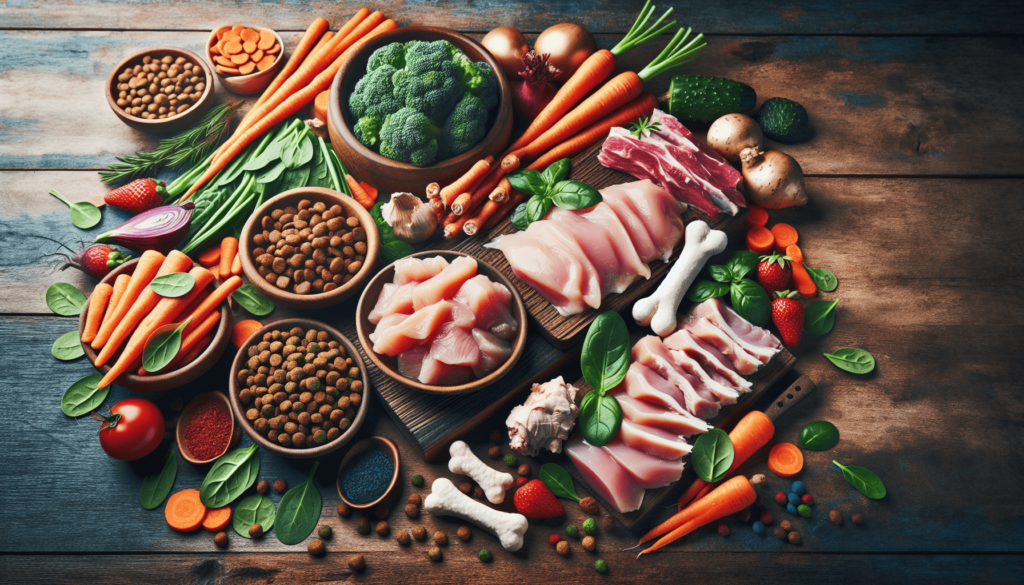Have you ever wondered if raw feeding is beneficial for dogs? This topic has stirred quite the conversation among pet owners and veterinary professionals alike. In recent years, there’s been a growing trend toward providing our furry friends with more natural, raw diets as opposed to the traditional commercial options. As someone who’s fascinated by the nuances of pet nutrition, I’m thrilled to explore this subject with you. Whether you’re a seasoned dog owner or someone considering welcoming a canine companion into your home, understanding the potential advantages and drawbacks of raw feeding can be a vital part of ensuring your dog’s health and happiness.

What is Raw Feeding?
Raw feeding, often called a raw food diet, involves providing dogs with a diet primarily consisting of uncooked meat, bones, fruits, and vegetables. This approach aims to mimic the natural diet of dogs’ wild ancestors, offering nourishment in the form it was typically found in the wild. The idea is centered around giving dogs a meal that is unprocessed and free from preservatives and artificial ingredients.
The Evolution of Raw Feeding
The concept of raw feeding isn’t new. It draws inspiration from how wolves and other wild canids have consumed their food for centuries. The commercial version of raw diets was popularized in the late 20th century by Australian veterinarian Dr. Ian Billinghurst, who proposed the BARF diet (Bones and Raw Food or Biologically Appropriate Raw Food). His proposition emphasized the potential health benefits of feeding dogs raw, unprocessed foods similar to what their predecessors would have naturally found.
Components of a Raw Diet
A typically raw food diet for dogs includes:
- Muscle Meat: Usually the foundation of the diet, often served on the bone.
- Raw Meaty Bones: Provide calcium and other essential nutrients.
- Organ Meats: Such as liver, which are nutrient-dense.
- Vegetables and Fruits: For vitamins and fiber.
- Eggs and Dairy Products: Occasionally included for added nutrients.
Understanding the composition can help you decide if this diet aligns with your beliefs and goals for your pet’s health. But what benefits does it potentially offer?
Benefits of Raw Feeding for Dogs
Many proponents of raw feeding argue that this diet can enhance a dog’s overall health and well-being. Let’s dive into some of the commonly cited benefits.
Improved Coat Conditions
One of the most frequently reported benefits by raw feeders is an improvement in their dog’s coat condition. The essential fatty acids found in raw diets are said to contribute to shinier, thicker fur. Raw diets naturally include higher levels of healthy fats that can promote a sheen and robust coat that’s less prone to shedding and dandruff.
Dental Health and Cleaner Teeth
Chewing on raw, meaty bones can help keep a dog’s teeth clean, naturally reducing the buildup of plaque and tartar. The mechanical action of chewing bones is similar to brushing their teeth, which can also contribute to fresher breath — a significant perk for close contact times.
Enhanced Digestion and Smaller Stools
Dogs on raw diets often experience better digestion, which can manifest in firmer, smaller stools. Since raw food is more natural and less processed, it’s easier for a dog’s digestive system to break down, absorb, and utilize the nutrients efficiently. This means less waste and, consequently, smaller bowel movements.
Increase in Energy Levels
Many dog owners report increased vitality in their pets once they switch to a raw food diet. This uptick in energy can often be attributed to a cleaner diet free of fillers and by-products, allowing pets to gain the maximum benefits from the nutrients they consume.

Potential Risks and Concerns
Despite the benefits, raw feeding isn’t without its controversies or potential downsides. It’s essential to consider these carefully before making any dietary changes for your dog.
Risk of Bacterial Contamination
Handling raw meat can pose significant risks for bacterial contamination, such as Salmonella or E. coli, which can affect both pets and humans. Proper handling, hygiene, and sourcing practices are crucial to mitigate these risks, but they can be a reason for concern, especially in homes with young children, elderly, or immunocompromised individuals.
Nutritional Imbalance
Ensuring a balanced diet is crucial for your dog’s health. Raw diets require meticulous planning to make sure they include the correct ratios of meat, bones, organs, and other components to meet all of a dog’s nutritional needs. Without consultation with a nutritionist or vet, it can be challenging to achieve a fully balanced diet consistently.
Bone Hazards
Feeding bones, while beneficial in many ways, can pose risks such as choking or internal injuries if pieces splinter and are ingested. It is vital to use appropriate-sized bones for your dog’s size and breed and always supervise them while eating.
Comparing Raw Feeding to Traditional Kibble Diets
So, how does raw feeding stack up against more traditional commercial kibble diets? Both diet types offer unique advantages and challenges.
Nutrient Density
Raw diets can be more nutrient-dense when properly formulated, as they lack fillers and artificial ingredients commonly found in kibble. However, premium kibble brands often add vitamins and minerals, ensuring a balanced meal without needing additional planning from the owner.
Convenience and Cost
Kibble is undeniably more convenient to store and serve. It doesn’t require refrigeration and has a long shelf life, making it a practical choice for many. Raw feeding, on the other hand, necessitates more prep work, precise purchasing, and careful storage, often at a higher financial cost.
Long-term Health Outcomes
While some praise raw feeding for long-term health benefits, more research is needed to make conclusive statements about these claims. Comparatively, scientific studies provide more comprehensive data on the efficacy of balanced kibble diets, backed by decades of research.
How to Transition to a Raw Food Diet
If you’re considering making the switch to raw feeding, it’s essential to understand how to transition your dog safely and effectively.
Gradual Introduction
Transitioning slowly can help prevent digestive upset. Begin by introducing a small amount of raw food alongside your dog’s current diet, gradually increasing the raw portion over several weeks.
Monitoring Health and Behavior
Closely monitor your dog’s health and behavior throughout the transition process. Notice any changes in stool quality, energy levels, or coat condition. Being vigilant will help you make necessary adjustments to their diet.
Consult with a Veterinarian
It is advisable to consult a veterinarian or a pet nutrition expert before making significant dietary changes. They can provide advice tailored to your dog’s unique health requirements and lifestyle needs.
Common Myths about Raw Feeding
As with any popular trend, raw feeding comes with its fair share of myths.
Myth 1: Raw Diets Are Always Safe
While many dogs thrive on raw diets, the risk of bacterial contamination can never be completely eliminated. Practicing food safety and hygiene is imperative.
Myth 2: Wolves Eat It, So It Must Be Right
Though dogs share a common ancestry with wolves, their digestion and nutritional needs have evolved due to domestication. Dogs are not wolves, and what works for one species may not necessarily suit the other.
Myth 3: A Raw Diet Is a Cure-All
There is no dietary silver bullet. While raw diets may confer specific benefits, they should not be seen as a panacea for all health issues.
FAQs
Is raw feeding safe for all dog breeds?
While many dogs can thrive on a raw diet, it is crucial to consider individual health conditions and breed specifications. Consulting with a vet is advisable.
How do I ensure a balanced raw diet for my dog?
Working with pet nutritionists or reputable raw dog food companies can ensure your pet receives a balanced diet with all necessary nutrients.
Can I mix raw and kibble diets?
Some owners successfully mix raw and kibble as part of a blended diet. However, consult your veterinarian to ensure this approach won’t lead to digestive issues or nutritional imbalances.
Will raw feeding lead to aggressive behavior in dogs?
There is no scientific evidence to support the claim that raw feeding enhances aggressive behavior. Behavioral issues should be addressed with proper training and management, independent of diet.
What is the most essential factor to consider when raw feeding?
Ensuring nutritional balance and food safety should be your primary considerations. Achieving this ensures your dog receives all the essential nutrients while minimizing the risk of bacterial contamination.
In conclusion, while raw feeding can provide numerous health benefits, it also requires careful consideration and planning. Balancing the pros and cons with the specific needs and lifestyle of your dog is paramount. Ultimately, a well-informed decision tailored to your pet can lead to a happier, healthier life together.



